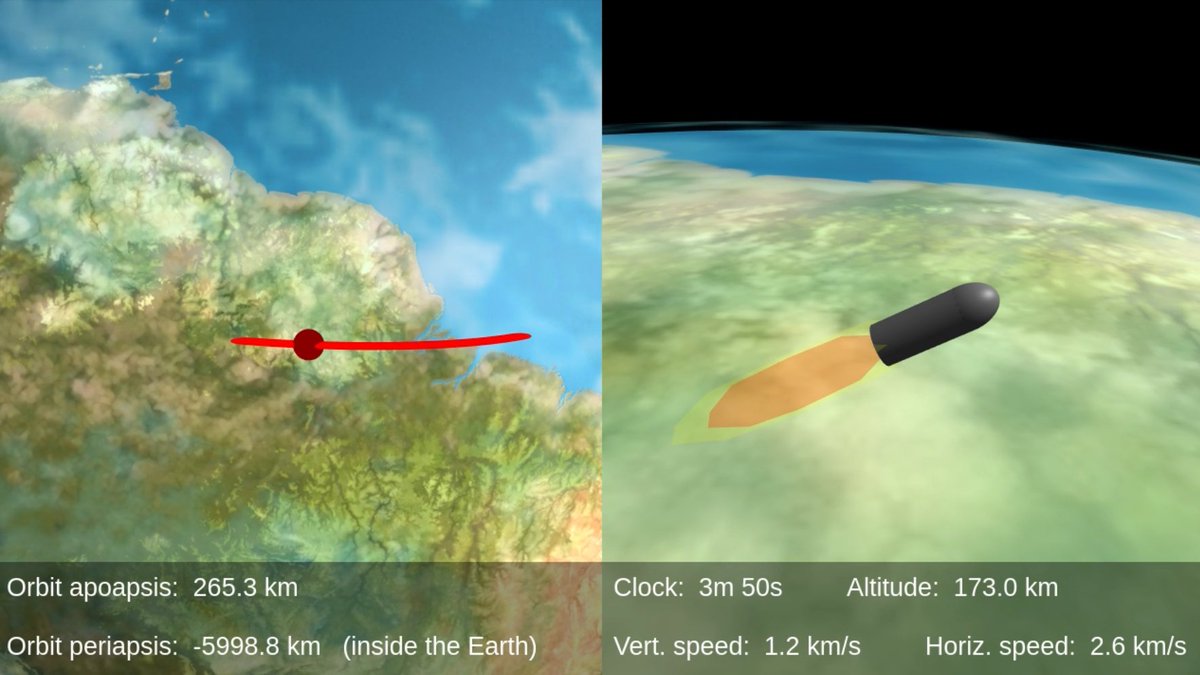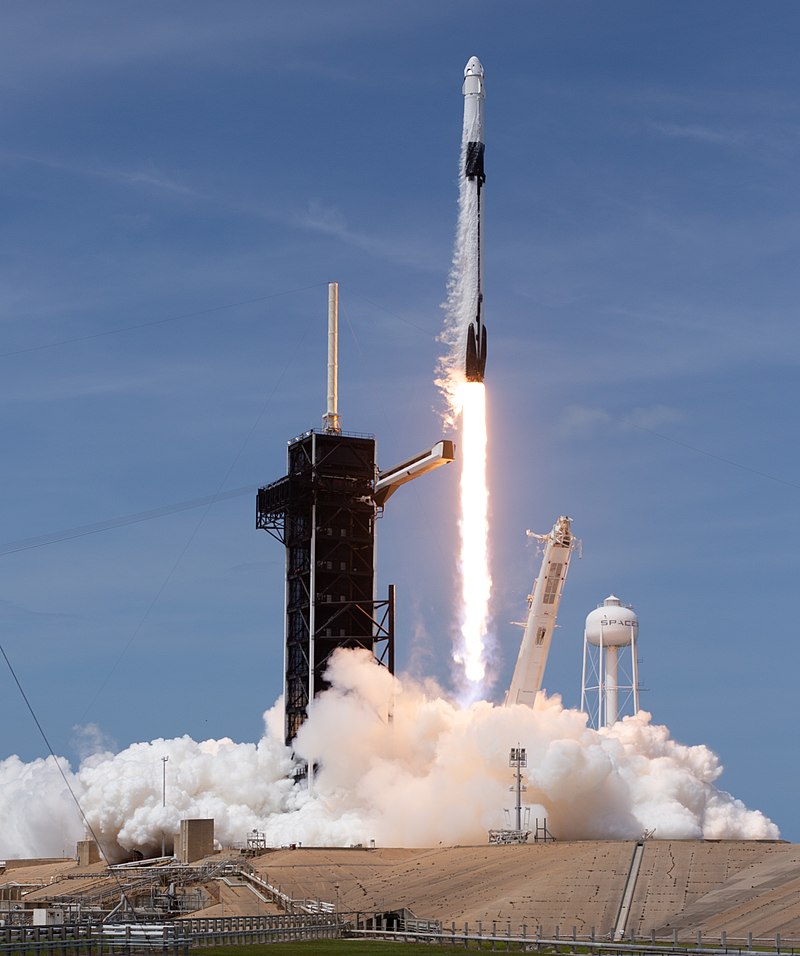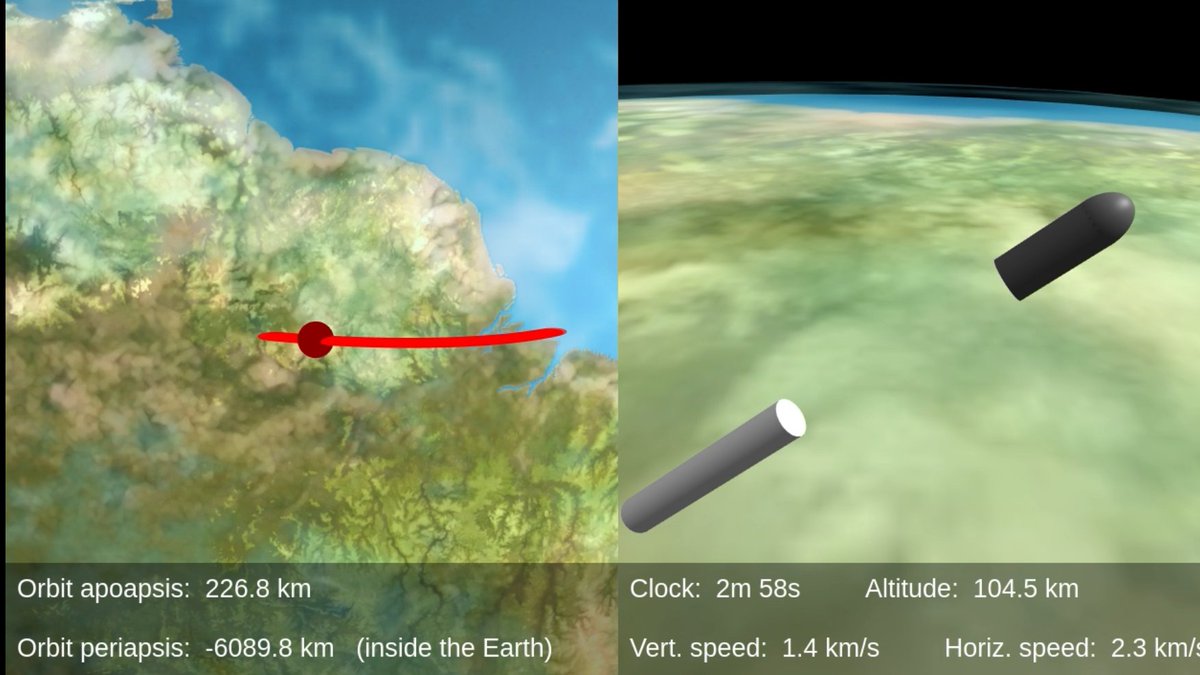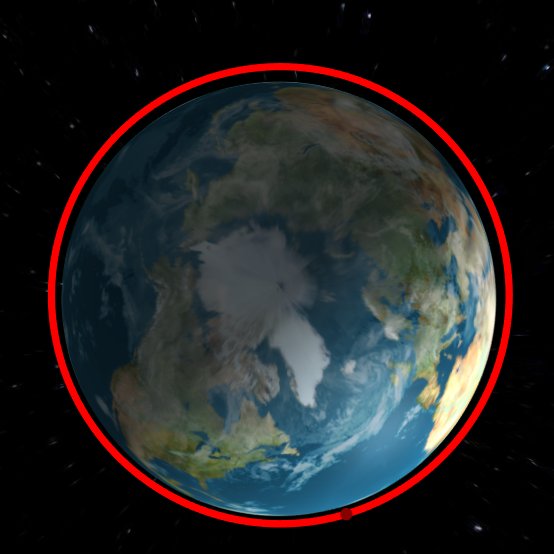An animation showing how rockets get to orbit, with details in the thread 1/
(Animation at 10x real time)
(Animation at 10x real time)
The dot on the LHS shows the position of the rocket.
The red path is the current orbit; the elliptical trajectory the rocket would follow if it went into free fall. Until the very end, this trajectory intersects the Earth (the rocket would crash if the engines cut out) 2/
The red path is the current orbit; the elliptical trajectory the rocket would follow if it went into free fall. Until the very end, this trajectory intersects the Earth (the rocket would crash if the engines cut out) 2/
Towards the end, I show the part of the trajectory that still intersects the Earth (in white), so you can see how the orbit changes as we accelerate
(This is the path we'd follow in freefall if the Earth weren't in the way and all of Earth's mass was at its core) 3/
(This is the path we'd follow in freefall if the Earth weren't in the way and all of Earth's mass was at its core) 3/
The rocket is roughly modelled on a @SpaceX Falcon 9 Full Thrust in expendable configuration 4/
(image source: https://en.wikipedia.org/wiki/Falcon_9#/media/File:SpaceX_Demo-2_Launch_(NHQ202005300044)_(cropped).jpg)
(specs taken from: https://www.spacelaunchreport.com/falcon9ft.html )
(image source: https://en.wikipedia.org/wiki/Falcon_9#/media/File:SpaceX_Demo-2_Launch_(NHQ202005300044)_(cropped).jpg)
(specs taken from: https://www.spacelaunchreport.com/falcon9ft.html )
Sci-fi tends to be bad at making a distinction between getting to space and getting to orbit.
To get to orbit by rocket you need to do two things:
1) get to space
2) stay in space while you get up to orbital velocity
Step 1 is the easy part! 5/
To get to orbit by rocket you need to do two things:
1) get to space
2) stay in space while you get up to orbital velocity
Step 1 is the easy part! 5/
It takes the rocket nearly 10 minutes to get to orbital, but by 3 minutes we've crossed the Kármán line (100 km altitude), so are already "in space"
6/
6/
Beyond the Kármán line, aerodynamic lift stops being useful: the air is so thin that to get sufficient aerodynamic lift to keep aloft you need to be going faster than orbital velocity anyway 7/
Once you're in space, you then need to get up to orbital velocity, which is about 7.8 km/s for low Earth orbit.
This animation nicely shows how 'being in orbit' is just 'moving quickly enough to keep missing the ground': https://twitter.com/CentrlPotential/status/1245032425958318083
8/
This animation nicely shows how 'being in orbit' is just 'moving quickly enough to keep missing the ground': https://twitter.com/CentrlPotential/status/1245032425958318083
8/
To reinforce the idea that getting up to orbital velocity is the hard part, here's the free-fall path of the rocket 1) at the moment of launch, 2) when crossing the Kármán line, and 3) when in orbit.
9/
9/
Here's a different version of the animation that shows the full free-fall trajectory throughout
(The free-fall path before launch isn't straight down because the Earth is spinning, so the rocket has some horizontal velocity already) 10/
(The free-fall path before launch isn't straight down because the Earth is spinning, so the rocket has some horizontal velocity already) 10/
I framed getting to orbit as a two-stage process: 1) get to space, then 2) get to orbital velocity.
But notice that by the time our rocket was above the Kármán line, it had already picked up 2.3 km/s of horizontal velocity 11/
But notice that by the time our rocket was above the Kármán line, it had already picked up 2.3 km/s of horizontal velocity 11/
Rockets follow a smooth curve called a 'gravity turn'. They start off going nearly vertically upwards, and naturally tilt over as gravity saps the vertical speed but not the horizontal.
This is done for efficiency and to keep the angle of attack low when in atmosphere 12/
This is done for efficiency and to keep the angle of attack low when in atmosphere 12/
Rockets are huge compared to their payloads because they accelerate by expelling mass (fuel) out the back. The catch is that when you add fuel, you have to add extra fuel to accelerate the fuel, and so on.
This is captured by the Tsiolkovsky rocket equation 13/
This is captured by the Tsiolkovsky rocket equation 13/
In the next few weeks, I'll make additional animations about proposed alternative methods of getting to orbit that avoid the problem of carrying fuel 14/
Inaccuracies in the animation:
- I don't account for air resistance when in atmosphere
- The rocket follows a reasonable trajectory, but does not attempt to mimic the true flight path of a Falcon 9 Full Thrust rocket
15/15
- I don't account for air resistance when in atmosphere
- The rocket follows a reasonable trajectory, but does not attempt to mimic the true flight path of a Falcon 9 Full Thrust rocket
15/15
16/15
I can't believe I made a thread about rocket launches and didn't mention why rockets have multiple stages.
The short version: it's to avoid having to accelerate excess/waste mass (empty fuel tanks and huge engines) all the way to orbit
I can't believe I made a thread about rocket launches and didn't mention why rockets have multiple stages.
The short version: it's to avoid having to accelerate excess/waste mass (empty fuel tanks and huge engines) all the way to orbit

 Read on Twitter
Read on Twitter








